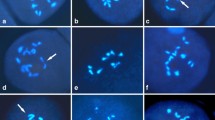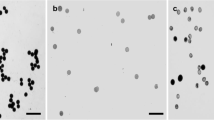Abstract
Abnormal meiotic chromosome behavior and pollen variation in two intersectional hybrids between Populus simonii Carr. (section Tacamahaca Spach) and Populus euphratica Oliv. (section Turanga Bge.) were investigated by the squashed technique and indirect immunofluorescence. Both hybrids produced abnormal flower buds characterized by a primary bud with an accessary bud at frequencies of 39.0 and 17.8 %, respectively. Chromosome pairing analysis at late diakinesis showed average configurations 20.31 I + 7.04 II + 1.42 III + 0.04 IV in hybrid “Xhu-DK” and 19.18 I + 7.16 II + 1.45 III + 0.04 IV in hybrid “Xhu-TL”, indicating high divergence between their parent species. Meiotic abnormalities, including precocious chromosome migration, lagging chromosomes, chromosome bridges, and micronuclei, were observed at high frequency, resulting in imbalanced chromosome segregation and chromosome elimination and caused high gamete sterility. Some micronuclei triggered formation of minispindles in Metaphase II, which were responsible for the formation of microcytes. Fused and tripolar spindles in the second meiotic division developed into dyads and triads, respectively, leading to viable first meiotic division restitution (FDR) type unreduced pollen formation. However, Xhu-TL was completely sterile because the high frequency of precocious cytokinesis during the second division prevented unreduced pollen formation though spindle fusion. Xhu-DK produced 29.6 % viable pollen grains. The diameter of viable pollen ranged from 19.6 to 64.9 μm, suggesting that Xhu-DK might be capable of producing unreduced pollen or pollen with a higher ploidy level. The strategy of using the distant hybrids for chromosome introgression and polyploidy breeding in Populus L. was considered.





Similar content being viewed by others
References
Anton KA, Ward JR, Cruzan MB (2013) Pollinator-mediated selection on floral morphology evidence for transgressive evolution in a derived hybrid lineage. J Evol Biol 26(3):660–673
Becerra Lopez-Lavalle LA, Orjeda G (2002) Occurrence and cytological mechanism of 2n pollen formation in a tetraploid accession of Ipomoea batatas (sweet patato). J Hered 93(3):185–192
Bednara J, Gielwanowska I, Rodkiewicz B (1986) Regular arrangements of mitochondria and plastids during sporogenesis in Equisetum. Protoplasma 130:145–152
Bretagnolle F, Thompson JD (1995) Gametes with the somatic chromosome number: mechanisms of their formation and role in the evolution of polyploid plants. New Phytol 129(1):1–22
Cervera MT, Storme V, Soto A, Ivens B, Van Montagu M, Rajora OP, Boerjan W (2005) Intraspecific and interspecific genetic and phylogenetic relationships in the genus Populus based on AFLP markers. Theor Appl Genet 111(7):1440–1456
De Storme N, Geelen D (2013) Sexual polyploidization in plants—cytological mechanisms and molecular regulation. New Phytol 198(3):670–684
Einspahr DW (1984) Production and utilization of triploid hybrid aspen. Iowa State J Res 58(4):401–409
FAO (2012) Synthesis of country progress reports. Food and Agriculture Organization of the United Nations: the 24rd session of the International Poplar Commission, Dehradun
Farco GE, Dematteis M (2014) Meiotic behavior and pollen fertility in triploid and tetraploid natural populations of Campuloclinium macrocephalum (Eupatorieae, Asteraceae). Plant Syst Evol 300(8):1843–1852
Fuzinatto VA, Pagliarini MS, Valle CB (2007) Evidence of programmed cell death during microsporogenesis in an interspecific Brachiaria (Poaceae: Panicoideae: Paniceae) hybrid. Genet Mol Res 6(2):308–315
Girke A, Schierholt A, Becker HC (2012) Extending the rapeseed gene pool with resynthesized Brassica napus II: Heterosis. Theor Appl Genet 124(6):1017–1026
Halket AC (1932) A note on the occurrence of abnormal flowers of Nasturtium officinale R. Br New Phytol 31(4):284–286
He JH, Shahid MQ, Chen ZX, Chen XA, Liu XD, Lu YG (2011) Abnormal PMC microtubule distribution pattern and chromosome behavior resulted in low pollen fertility of an intersubspecific autotetraploid rice hybrid. Plant Syst Evol 291(3–4):257–265
Jansson S, Douglas CJ (2007) Populus: a model system for plant biology. Annu Rev Plant Biol 58:435–458
Jauhar PP (2007) Meiotic restitution in wheat polyhaploids (amphihaploids): a potent evolutionary force. J Hered 98(2):188–193
Kalloo G (1992) Utilization of wild species. In: Kalloo G, Chowdhury JB (eds) Distant hybridization of crop plants. Springer, Berlin Heidelberg, pp 149–167
Kamstra SA, Ramanna MS, de Jeu MJ, Kuipers AG, Jacobsen E (1999) Homoeologous chromosome pairing in the distant hybrid Alstroemeria aurea × A. inodora and the genome composition of its backcross derivatives determined by fluorescence in situ hybridization with species-specific probes. Heredity 82:69–78
Kang XY (1996) Secondary chromosomal synapsis and evolution of Populus. J Gansu Agric Univ 31(4):323–326
Kang XY, Zhu ZT (1997) A study on the 2n pollen vitality and germinant characteristics of white poplars. Acta Bot Yun 19(4):402–406
Kang XY, Zhu ZT, Zhang ZY (2000) Meiosis and its stages of pollen mother cells in Chinese white poplar. J Beijing For Univ 22(6):5–7
Khan MMR, Hasnunnahar M, Isshiki S (2013) Production of amphidiploids of the hybrids between Solanum macrocarpon and eggplant. HortSci 48(4):422–424
Kumar S, Imtiaz M, Gupta S, Pratap A (2011) Distant hybridization and alien gene introgression. In: Pratap A, Kumar J (eds) Biology and breeding of food legumes. CABI, Oxfordshire, pp 81–110
Liberloo M, Calfapietra C, Lukac M, Godbold D, Luo ZB, Polle A, Hoosbeek MR, Kull O, Marek M, Raines C, Rubino M, Taylor G, Scarascia-Mugnozza G, Ceulemans R (2006) Woody biomass production during the second rotation of a bio-energy Populus plantation increases in a future high CO2 world. Glob Chang Biol 12:1094–1106
Liu D, Zhang H, Zhang L, Yuan Z, Hao M, Zheng Y (2014) Distant hybridization: a tool for interspecific manipulation of chromosomes. In: Pratap A, Kumar J (eds) Alien gene transfer in crop plants, vol 1, Innovations, methods and risk assessment. Springer, New York, pp 25–42
Mashkina OS, Burdaeva LM, Belozerova MM, Vyunova LN (1989) Method of obtaining diploid pollen of woody species. Lesovedenie 1:19–25
Moreno PE, Caetano CM, Olaya CA, Agrono TC, Torres EA (2014) Chromosome elimination in intergeneric hybrid of Oryza sativa × Luziola peruviana. Agric Sci 5(13):1344–1350
Naghiloo S, Dadpour MR, Gohari G, Endress PK (2013) Comparative study of inflorescence development in Oleaceae. Am J Bot 100(4):647–663
Ortiz AM, Seijo JG, Fernández A, Lavia GI (2011) Meiotic behavior and pollen viability of tetraploid Arachis glabrata and A. nitida species (Section Rhizomatosae, Leguminosae): implications concerning their polyploid nature and seed set production. Plant Syst Evol 292(1–2):73–83
Rae AM, Street NR, Rodríguez-Acosta M (2007) Populus trees. In: Kole C (ed) Genome mapping and molecular breeding in plants, vol 7, Forest trees. Springer, Berlin Heidelberg, pp 1–28
Risso-Pascotto C, Pagliarini MS, do Valle CB, Jank L (2004) Asynchronous meiotic rhythm as the cause of selective chromosome elimination in an interspecific Brachiaria hybrid. Plant Cell Rep 22(12):945–950
Risso-Pascotto C, Pagliarini MS, do Valle CB (2005) Meiotic behavior in interspecific hybrids between Brachiaria ruziziensis and Brachiaria brizantha (Poaceae). Euphytica 145(1–2):155–159
Sannigrahi P, Ragauskas AJ, Tuskan GA (2010) Poplar as a feedstock for biofuels: a review of compositional characteristics. Biofuels Bioprod Bioref 4(2):209–226
Seitz FW (1954) The occurrence of triploids after self-pollination of anomalous androgynous flowers of a grey poplar. Z Forstgenet 3(1):1–6
Shamina NV, Gordeeva EI, Kovaleva NM, Seriukova EG, Dorogova NV (2007) Formation and function of phragmoplast during successive cytokinesis stages in higher plant meiosis. Cell Biol Int 31:1–10
Silkova OG, Shchapova AI, Shumny VK (2011a) Meiotic restitution in amphihaploids in the tribe Triticeae. Russ J Genet 47(4):383–393
Silkova OG, Shchapova AI, Shumny VK (2011b) Patterns of meiosis in ABDR amphihaploids depend on the specific type of univalent chromosome division. Euphytica 178(3):415–426
Soltis PS, Soltis DE (2009) The role of hybridization in plant speciation. Annu Rev Plant Biol 60:561–588
Sosnowska K, Cegielska-Taras T (2014) Application of in vitro pollination of opened ovaries to obtain Brassica oleracea L. × B. rapa L. hybrids. In Vitro Cell Dev Biol Plant 50(2):257–262
Sterck L, Rombauts S, Jansson S, Sterky F, Rouzé P, Van de Peer Y (2005) EST data suggest that poplar is an ancient polyploid. New Phytol 167(1):165–170
Tang QY (2010) Studies on hybridization of Tacamahaca and Populus euphratica and their chromosome doubling technique. Dissertation, Beijing Forestry University
Tel-Zur N, Abbo S, Mizrahi Y (2005) Cytogenetics of semi-fertile triploid and aneuploid intergeneric vine cacti hybrids. J Hered 96(2):124–131
Trojak-Goluch A, Berbeć A (2003) Cytological investigations of the interspecific hybrids of Nicotiana tabacum L. × N. glauca Grah. J Appl Genet 44(1):45–54
Tuskan GA, DiFazio S, Jansson S et al (2006) The genome of black cottonwood, Populus trichocarpa (Torr. & Gray). Science 313(5793):1596–1604
Wang J, Kang X (2009) Distribution of microtubular cytoskeletons and organelle nucleoids during microsporogenesis in a 2n pollen producer of hybrid Populus. Silvae Genet 58(5/6):220–226
Wang J, Kang X, Zhu Q (2010) Variation in pollen formation and its cytological mechanism in an allotriploid white poplar. Tree Genet Genomics 6(2):281–290
Wang J, Wu Y, Ren G, Guo Q, Liu J, Lascoux M (2011) Genetic differentiation and delimitation between ecologically diverged Populus euphratica and P. pruinosa. PLoS One 6(10), e26530
Ward JR, Cowart ML, Clifford J, Camp M, Cruzan MB (2014) Variation in sex allocation and floral morphology in an expanding distylous plant hybrid complex. Int J Plant Sci 175(5):518–525
Xu WY (1988) Poplar. Heilongjiang People’s Publishing House, Harbin
Zhang Z, Kang X, Zhang P, Li Y, Wang J (2007) Incidence and molecular markers of 2n pollen in Populus tomentosa Carr. Euphytica 154:145–152
Zhang LQ, Liu DC, Zheng YL, Yan ZH, Dai SF, Li YF, Jiang Q, Ye YQ, Yen Y (2010) Frequent occurrence of unreduced gametes in Triticum turgidum–Aegilops tauschii hybrids. Euphytica 172(2):285–294
Zhu ZT, Lin HB, Kang XY (1995) Studies on allotriploid breeding of Populus tomentosa B301 clones. Sci Silvae Sin 31:499–505
Acknowledgments
This work was supported by the Beijing Higher Education Young Elite Teacher Project (Grant No. YETP0758), the Program for New Century Excellent Talents in University (Grant No. NCET-13-0672), the Program for Changjiang Scholars and Innovative Research Team in University (Grant No. IRT13047), the Beijing Nova program (Grant No. Z141105001814007), and the Students’ Innovation and Entrepreneurship Training Program of BJFU (Grant No. X201410022032).
Data archiving statement
We have submitted no data to public databases.
Author information
Authors and Affiliations
Corresponding author
Additional information
Communicated by A. Brunner
The English in this document has been checked by at least two professional editors, both native speakers of English. For a certificate, please see:
http://www.textcheck.com/certificate/o1yJHH
This article is part of the Topical Collection on Hybridization
Rights and permissions
About this article
Cite this article
Wang, J., You, H., Tian, J. et al. Abnormal meiotic chromosome behavior and gametic variation induced by intersectional hybridization in Populus L.. Tree Genetics & Genomes 11, 61 (2015). https://doi.org/10.1007/s11295-015-0880-z
Received:
Revised:
Accepted:
Published:
DOI: https://doi.org/10.1007/s11295-015-0880-z




